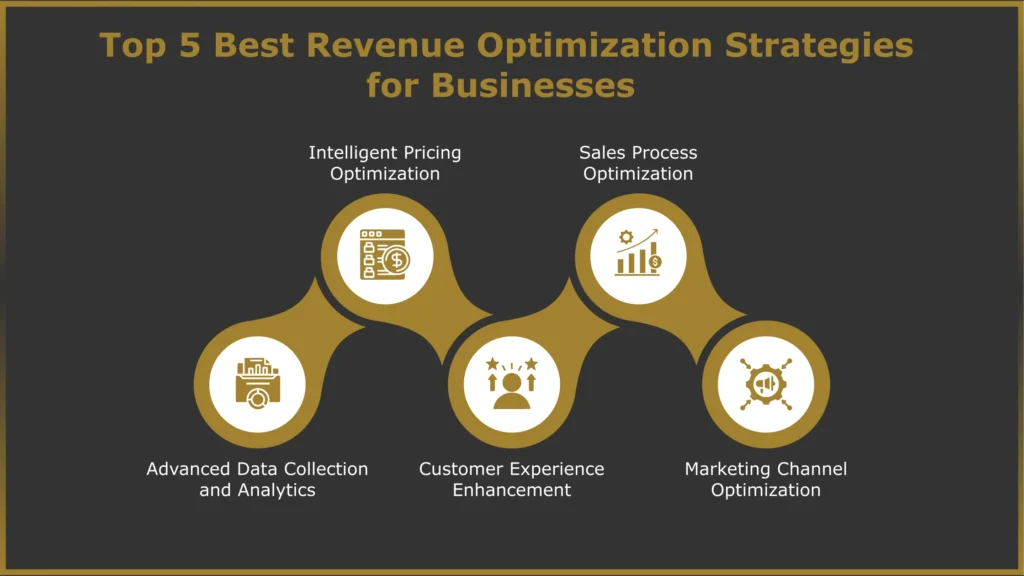Gone are the days when simply increasing sales was enough. Modern business success requires a sophisticated, multi-faceted approach to revenue optimization. Revenue cycle management optimization and revenue cycle optimization are crucial for sustainable growth.
According to recent research by Forrester, companies that adopt Revenue Operations and Intelligence (RO&I) solutions experience 69% higher revenue growth, 59% improved win/loss rates, and a 53% increased net-dollar retention. Understanding how to optimize revenue and achieve profit optimization requires a strategic approach combining innovative thinking and proven methodologies.
Implementing an effective revenue optimization system is essential to staying competitive in 2025. If you’re wondering, “How do you optimize revenue?” here are five basic strategies that will transform your business.
Top 5 Best Revenue Optimization Strategies for Businesses

Before discussing the strategies, let’s first understand revenue optimization.
Revenue optimization is a strategic approach combining various business elements to maximize income from existing resources and operations.
Recent data from Revenera’s 2023 Monetization Monitor reveals that only 32% of software suppliers feel that their pricing is “totally aligned” with the value they provide to customers. This indicates that pricing strategies can be improved significantly.
Data-driven decision-making is central to successful revenue optimization. According to research by the McKinsey Global Institute, data-driven organizations are 23 times more likely to acquire customers, 6 times as likely to retain customers, and 19 times more likely to be profitable. These findings emphasize the advantages of data analytics in business operations and demonstrate data’s crucial role in modern revenue optimization strategies.
1. Advanced Data Collection and Analytics
Effective revenue optimization begins with sophisticated data collection and analysis as its foundation. Modern businesses must develop comprehensive systems for gathering and interpreting customer data across all touchpoints. This includes understanding purchase patterns, customer behaviors, and interaction preferences.
Setting up proper analytics systems requires more than just installing tracking software. It demands a thoughtful approach to what data you collect and how you use it. Companies should focus on gathering meaningful insights about customer lifetime value, acquisition costs, and engagement patterns. This information becomes the foundation for all other optimization strategies.
Real-time monitoring and regular data review processes help businesses stay agile and responsive to market changes. By establishing clear metrics and reviewing them consistently, companies can identify trends early and adjust their strategies accordingly. The aim is to move beyond simple data collection to meaningful analysis that drives action.
2. Intelligent Pricing Optimization
Pricing optimization is one of the most effective ways to boost revenue. According to McKinsey’s research, a mere 1% improvement in pricing can result in an 11.1% increase in operating profits. This makes pricing strategy a crucial element of revenue optimization.
Value-based pricing forms the foundation of modern pricing strategies. This approach requires understanding what customers truly value about your product or service and aligning your pricing accordingly. It goes beyond simple cost-plus pricing to consider market positioning, competitor pricing, and customer perception of value.
Dynamic pricing has become increasingly important in 2025’s competitive business environment. This involves real-time adjusting prices based on market conditions, demand, and competitor behavior. Successfully implementing dynamic pricing requires sophisticated technology and careful monitoring to ensure pricing remains competitive and profitable.
Bundle pricing represents another powerful technique in the pricing optimization arsenal. Creating effective bundles requires a deep understanding of customer needs and preferences. The goal is to create packages that provide additional value to customers while increasing overall revenue per transaction.
3. Customer Experience Enhancement
Creating exceptional customer experiences has become crucial for sustainable revenue growth. Research indicates that 86% of buyers are willing to pay more for a great customer experience, making this a vital area for revenue optimization.
Personalization is not limited to simple name insertion in emails. Modern personalization involves creating tailored experiences across all customer touchpoints. This requires sophisticated technology to track customer preferences and behavior and artificial intelligence to deliver relevant experiences at scale.
Customer support has transformed from a cost center to a revenue driver. Modern support systems combine human expertise with artificial intelligence to provide round-the-clock assistance. The goal is to resolve issues quickly while identifying opportunities to enhance customer value.
The user journey has become increasingly complex in the modern world. Successful companies map out every touchpoint in the customer journey, identifying and eliminating friction points. This process requires continuous monitoring and adjustment based on customer feedback and behavior data.
4. Sales Process Optimization
According to Clari’s research, optimized sales teams see an 80% increase in effectiveness and a 448% ROI. This remarkable improvement comes from carefully refining every aspect of the sales process.
Modern sales automation goes beyond simple email sequences. It involves creating sophisticated workflows that guide prospects through the sales funnel while maintaining a personal touch. It’s crucial to automate routine tasks while preserving the human elements that build relationships and trust.
Modern sales teams need continuous training and support to stay effective in a rapidly changing market. This includes regular coaching sessions, access to advanced sales tools, and clear processes for handling different prospects and situations. Operational Efficiency: A Guide to Improve Your Business Operations offers insights into achieving these goals.
Performance monitoring has become more sophisticated, with advanced metrics tracking sales outcomes and the entire sales process. This allows for precisely identifying areas needing improvement and more effective coaching interventions.
5. Marketing Channel Optimization
Marketing channel optimization requires a clear understanding of how channels drive revenue. The focus has shifted from individual channel performance to understanding the customer journey across multiple touchpoints.
Digital marketing excellence requires more than just maintaining a presence across various channels. It demands a deep understanding of how each channel contributes to revenue. This includes sophisticated attribution modeling to understand the true impact of different marketing activities.
Content strategy is not just limited to creating engaging content. Modern content strategy focuses on creating value throughout the customer journey, from initial awareness to post-purchase support. This requires careful planning and measurement to ensure content effectively drives revenue growth.
Essential Tools and Technologies for Revenue Optimization
The technology stack required for effective revenue optimization has grown increasingly sophisticated. Modern businesses need integrated systems that combine customer relationship management, analytics, marketing automation, and sales enablement tools. According to Forrester’s projections, the customer revenue optimization software market is expected to grow from $9.7 billion in 2023 to $20 billion by 2033.
Other strategies that you can implement include:
- Implement proven sales strategies to increase sales across all channels
- Explore innovative ways to increase sales through integrated team approaches
- Deploy cutting-edge revenue operations tools for enhanced performance tracking
- Transform traditional product offerings into subscription-based models
- Develop innovative pricing tiers that cater to different customer segments
- Implement effective strategies to increase sales through recurring revenue models
- Focus on creating a sales strategy plan that maximizes account value
- Develop account health scoring systems to predict and prevent churn
- Create targeted expansion campaigns based on customer usage patterns
Metrics for Evaluating Revenue Optimization Success
Success in revenue optimization requires careful attention to various metrics that provide a complete picture of business performance. Financial metrics include revenue cycle management optimization, revenue growth, profit margins, and customer lifetime value. Customer metrics focus on satisfaction and engagement levels, while operational metrics track the efficiency of various business processes.
To ensure your optimization efforts are working, track these metrics:
- Customer Lifetime Value (CLV)
- Customer Acquisition Cost (CAC)
- Revenue Per Customer
- Customer Retention Rate
- Net Revenue Retention (NRR)
Overcoming the Challenges in Revenue Optimization
1. Ensuring Data Quality
High-quality data is essential for effective revenue optimization. Inaccurate or incomplete data can derail even the best strategies. Leading organizations must prioritize strong data validation processes and conduct regular audits to maintain the accuracy and reliability of their information, ensuring decisions are grounded in trustworthy insights.
2. Streamlining Technology Integration
Integrating multiple systems and data sources can be a daunting task. Challenges arise when tools and platforms are incompatible, creating inefficiencies and data silos. Successful integration requires strategic planning and selecting technologies that can work seamlessly together, creating a unified approach to revenue management.
3. Enhancing Team Alignment
Revenue optimization initiatives often falter due to misaligned objectives across departments. Breaking down silos and promoting collaboration is critical to success. Establishing clear goals, fostering open communication, and unifying teams under a shared vision ensures that all stakeholders work cohesively to achieve optimal outcomes.
Get Ready to Transform Your Revenue Strategy With Outcomes COO

Don’t let outdated approaches hold back your revenue potential. Outcomes COO’s expert team can help you implement these cutting-edge strategies and achieve unprecedented growth in 2025.
Our revenue optimization experts will:
- Assess your current revenue operations and identify growth opportunities
- Develop a customized strategy that aligns with your business goals
- Guide implementation and provide ongoing optimization support
- Monitor and measure results to ensure ROI
Discover how Outcomes COO can help you maximize your revenue potential in 2025. Our proven approach has helped businesses achieve up to 40% revenue growth within the first year.
FAQs
1. What are the five steps of optimization?
The five fundamental steps of revenue optimization are:
- Data collection and analysis: Gathering and interpreting relevant data
- Strategy development: Creating targeted optimization plans
- Implementation: Executing planned strategies
- Monitoring and measurement: Tracking performance metrics
- Continuous improvement: Making ongoing adjustments based on results
2. What is the first rule of optimization?
The first rule of optimization is establishing accurate baseline measurements and understanding your current situation thoroughly before making any changes. This ensures that improvements can be adequately measured and validated.
3. What role does technology play in revenue optimization?
Technology is crucial in revenue optimization, enabling businesses to analyze data, forecast trends, and automate processes. Tools like CRM software, pricing platforms, and AI-based analytics help streamline strategies and drive better outcomes.
4. How can businesses ensure long-term success with revenue optimization?
Businesses can ensure long-term success by continuously revisiting their strategies, incorporating feedback, adapting to market changes, and utilizing insights from data analytics to make informed decisions. Regular evaluation and flexibility are crucial.

